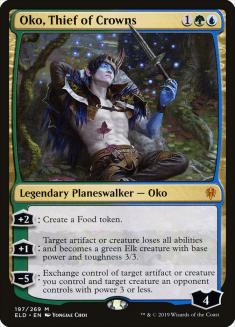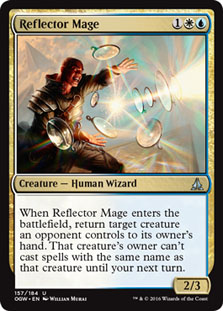As many of you likely know, I spent the last month working a short-term consulting contract with Play Design at Wizards of the Coast (WotC). While I can’t talk about the product I was working on, I have received permission to talk about some things I learned about what working there is like and how they do things. I know a lot of Magic players think about working in game design someday, and others just like to have a better idea of the process that leads to the cards we play with, so I thought I’d try to sum up what I could from the experience.
New hires at WotC talk about how there’s a lot to absorb when they first get there, since they need to catch up on a couple of years of cards that are all in a confirmed final form, but which the public doesn’t know about when they arrive. This tends to create a gap for players there where they don’t know the cards that were released after they were hired but before the first set they worked on very well. They’ve read through the future set list(s) and played with cards they’re testing in Constructed, but if the work on the set is done there’s no reason they’d know the cards that their coworkers aren’t using in Constructed very well.
Things were a bit different for me. Because I’m a player and I was only there on a short contract, the goal was to make sure that I didn’t have enough information about future releases to offer any competitive advantage, which meant that I learned about very few cards outside of the the cards I was actually working on. Despite the massively abridged pool of cards I needed to learn, getting caught up – just completing a first pass – took several days. This is because there was a lot of other stuff to do, so I had to work familiarizing myself with everything in around a busy schedule of meetings and stuff.
“Meetings” isn’t very informative – as someone who’d never worked a standard office job, I hear about meetings a lot and they seem like a pretty normal office job type thing, but it’s probably not obvious how they work in a Play Design context. Allow me to back up and describe my process a little more chronologically.
I showed up at 9:30am Monday morning the day my contract started and started off by getting a badge made and going over some logistics about how submitting my hours and getting paid would work. Then I was brought to the cubicle I’d be at for the next month. The cubicle was on the fourth floor, which is significant because the rest of Play Design, which I guess is formally part of “Studio X” these days (which, broadly, I think, are all the people who design Magic cards, but that might not be precisely it), is on the third floor. We were kept away from them to help make sure we didn’t learn too much about future releases that we didn’t need to know. So we had a corner of a room generally designated for retail support. There were six cubicles in a 2×3 arrangement for three full-time staff members and three short-term consultants who’d be working together.
Our cubicles had a laptop that was connected to central control box that hooked it up to a couple of monitors, a mouse, and a keyboard so that we could use it as a desktop at our deck, yet easily pull it out to bring to meetings (which I never did). The desks had buttons that could change their height between a sitting and standing desk. We spent a lot of the first day getting our computers set up and learning how to log into all the systems and familiarizing ourselves with the programs we’d be working with where we could read and edit cards, and also build and print decks.
Printing decks is the greatest. As someone who read a lot of design articles years ago but hasn’t kept up lately, I know they used to use a lot of playtest stickers and stuff. These days, they have boxes of blank cards that you load into a card printer, and a minute later, you have a full deck. The cards don’t look or feel great, but they’re functional, and it’s by far the fastest way I’ve ever put a paper deck together, which made trying new decks really easy. I basically can’t imagine doing the job without it.
We were also introduced to Microsoft Teams and Outlook, which was set up with our temporary WotC email addresses and calendars. I hadn’t heard of Teams before, but it’s basically like Slack or Discord, which I’m pretty familiar with. It took a while to figure out how everything worked, like that people would email invitations to meetings and that those would go in a calendar that would set reminders that would tell me what I was supposed to be doing throughout the day. I started off by figuring I’d just ignore all that and do whatever I was told to do, since we were all in the same place. I didn’t imagine I’d miss anything, but after a couple of days I realized sometimes people would schedule meetings with me that didn’t involve the rest of the team, and I added checking my inbox to my daily routine when I got to work.
The first day, a large sheet of blank paper was hung up on the wall. Whenever anyone found a card they wanted to discuss, they wrote the card on the paper. At 4:00pm, we’d have a meeting to discuss all the cards that were written on the paper that day.
The most striking thing at first was how quickly cards changed. When I got there, there were a couple of holes in the set where there had been a previous design that they’d decided wasn’t working, but for the most part, there was an entire set. Many people had been involved in getting the set to where it was. A common experience that I’ve heard from players offering feedback to WotC on things like Organized Play is that the feedback is rarely listened to. One might expect that my job would just be to play with everything and just say “This will be another Oko” or not, but this wasn’t like that. While a lot of people had put work into the set, they know it’s all preliminary and everything’s expected to change.
If a card was written on the paper, it was very unlikely that it wouldn’t get changed in some way. Many cards changed every day, and when I got there, there were several cards I wanted to get rid of, and there was minimal resistance, as long as I could offer good reasons things shouldn’t be printed as they were. People weren’t attached to any particular design, and everyone understood that it’s better to try more versions of the cards, since if it isn’t an improvement, we can always revert.
I’ve talked about how as a player and deckbuilder, you can kind of view your goal as getting a card banned at some point. At WotC, players essentially get cards banned every few hours, and I quickly amassed a pile of outdated decks built around cards that were nerfed enough that the deck was no longer competitive. At least once this happened before I even played any games, when I explained how messed up an interaction I’d built a deck around could be.
The other big surprise went kind of hand in hand with the responsiveness to quick changes. The cards that I first saw when I got there were pushed. If a card was intended for Constructed, it was basically the most powerful version of its effect that could possibly have a chance of being reasonable. Creatures were huge and spells were cheap. Cards often had extra abilities for seemingly no reason.
This isn’t because they’re bad at their job and don’t know what reasonable cards look like. I’m sure similar changes to those I suggested would have been made by someone if I hadn’t been there – after all, most real sets are at least mostly reasonable. The idea is that it’s much easier and safer to make cards weaker than it is to make them stronger. A last-minute change that seems like a small knob can have a much bigger impact than you expect. If that happens when you’re making a card weaker, maybe the card doesn’t see much play, but if it happens when you’re making a card stronger, it could disrupt a whole format.
As I’ve heard it, Reflector Mage getting a third toughness was a last-minute change that was intended to help Azorius in Limited because it hadn’t been doing well enough, but no one tried it in Constructed because Reflector Mage hadn’t been intended as a Constructed card, since cards like that never had been, and at 2/2, it might not have been. So if you’re not sure how strong a card should ultimately end up, you start with the strongest you think might be right.
This also made it really easy to get a lot of the cards we were working on into decks. They were so pushed it seemed crazy not to play lots of them in any deck we were building, but that also helped make the process more efficient by getting more cards in each of our games.
After the first few days, we settled into a pretty steady routine – arrive in the morning, review all the changes from the day before, find cards that look too good, try to build decks that use them to show how broken they can be, spend a couple of hours in the morning building and printing a handful of decks to try out and show off different new cards, go to lunch, come back, play games with these decks for a few hours, write the names of cards that were too strong or otherwise didn’t seem to be accomplishing their intended goals, and then meet for a couple of hours to discuss our findings and suggestions for fixing things.
There was one major twist in this process, which is that the lead for the set wasn’t actually one of the six of us on the team I described. He had a cubicle nearby, but he also had a lot of other obligations outside of being the lead on this set, so he’d attend some of the meetings and occasionally stop by to play or watch a few games, but he was mostly hands-off. We’d tell him what we were experiencing and what we’d recommend, and he’d have final say, though the full-time employees we were working with were also free to make changes without him when it wasn’t a major change.
This had the amusing effect that things would change much more quickly when he was around, and if there was a card there’d been disagreement or uncertainty about changing, the fastest way to get it addressed, if possible, was to get it into a game with him. For the most part, I don’t think this is how things are generally done, but experienced leads were stretched a little thin.
Several teams are responsible for each set. A long time ago, I believe this was basically split into “designers” and “developers.” These days, as I understand it, a set goes through “Vision Design” (which I believe involves figuring out the setting and how it will be mechanically represented, so figuring out all the major mechanics and themes that will be present); “Set Design” (which involves essentially making a first draft of every card to fill out a set so that it’s all playable to be tuned); and “Play Design” (where they play with the cards to figure out how everything actually works together – this involves tuning all the numbers, but also regularly dropping or redesigning cards that just aren’t working well). I was on the Play Design team, but even as someone new there and working on tuning a set others had designed, I designed a lot of cards, because any time I had a problem with something, it was my responsibility to suggest a replacement.
Also, for the most part, Limited, at least from what I saw, is handled by set design, since you can’t really change a card in isolation, because what really matters is color and archetype balance, so everything requires a more holistic approach. I wasn’t brought on to work on that, but after running a lot of meetings for pro teams about Limited and doing my own analysis for my classes on Discord, I felt like I had tools to analyze the set that could be useful, and ended up working with someone from set design to go over my take on what was and wasn’t working with major set themes and mechanics and how it could be improved. That led to some larger meetings with the set design team and got a lot of cards changed, with suggestions for future development after I left.
That was probably the most satisfying part of the work that I did, and I think also pretty representative of how work there works. I had assigned responsibilities and tasks, but when I felt like there was something else I could add that they maybe didn’t know I’d be able to do, I was given enough leeway to make room to try it, and as long as I could make a solid case for how things should be, people were happy to listen.
The other major twist came at the end of the third week. The coronavirus concerns were really starting to hit Seattle and WotC decided everyone would switch to working at home. FFL teams, including mine, were given special permission to come in, since playing in person was necessary to doing our job, but coming in was optional if we had concerns, and we were supposed to spend as little time in the building as possible. We figured it was safe since the building was mostly empty and the six of us constituted a pretty small group. Personally, my primary interest in working on Magic has been that I’d like the regular socialization of working on set with people, so this wasn’t a great change for me, but fortunately it was only for the last week and we were still meeting in the afternoons.
For the most part, working at WotC was great. I enjoyed myself, felt really productive and respected, and everything went well. There was one meeting I had with my boss, I suppose, who wasn’t actually on the same team, about concerns about how I presented my positions – that I was too confident and there was a concern that I was using social pressure rather than reasoning to push for changes when there was resistance. It can be tricky to balance how much detail to go into in explaining reasoning for a change, because you need to figure out where the disagreement’s happening, and also not derail a meeting with extensive theoretical background on a position. Learning to balance getting through a meeting smoothly and then writing out my reasoning later so that whoever was interested could review and consider it on their own time took a little practice, but after talking through how they preferred to handle that kind of thing, I don’t think there were any more problems.
One of the weirdest things about being on a short-term contract is that I don’t actually know how cards will look when they’re printed. I know that work on the set is being handled by a small skeleton crew now that we’re gone and that we were supposed to get everything as close to finalized as possible, but there were still some things being worked on, and there were a few cards that I left long messages about why I’d make changes to them that hadn’t been made yet, so I’m looking forward to seeing the finished product to find out where they ultimately agreed with me and where they didn’t.
All in all, I think it was a great experience for everyone, and I’m looking forward to doing more work with WotC, and it sounds extremely likely that that will happen soon. I don’t know if it will ultimately take the form of a remote contract, short-term in-house contract like this, or full-time employment, but I’m confident something will come up soon.




